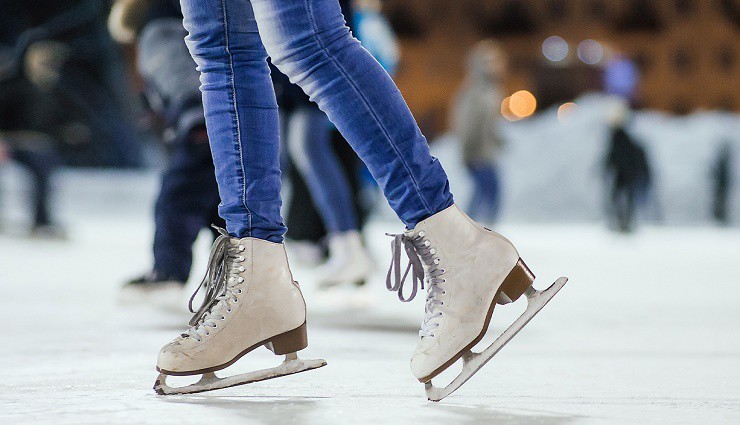Skating or ice skating is a recreational sport in that you use special shoes on the ice surface and perform various movements. Ice skating may be scary, but with enough training and practice, you can learn and become proficient in this sport. In the following, you will learn more about this sport and read the steps of learning skating.
What is skating?
Patinage is a French word that means ice skating. Ice skating began in Scandinavia in the early 1st millennium BC. The first skate shoes were made from things like calf and deer ribs. Over time, in Holland, metal blades were used to make these shoes. In 1950, a steel blade attached to skate shoes was invented in the United States of America. With the construction of ice rinks in London (1876) and the famous indoor arena in Madison Square Garden (1879), skating turned from a seasonal pastime into a popular sport.
As we said, skating is done on an ice rink. This rink is a frozen surface on which they do skating or winter sports. These tracks may be indoor or outdoor. Of course, ice skating can also be done on naturally frozen surfaces such as rivers or frozen waters. Skating is a beautiful sport and recreational activity that has no age limit.
Types of ice skating
There are different types of ice skating, including figure skating, speed skating, tour skating, and ice hockey.
1. Skate tour

It is a type of ice skating done as a sport and for fun. Skate tour is done over long distances and on natural frozen surfaces.
2. speed skating

The competitive type is ice skating; people compete to cover a certain distance with skates.
3. Figure skating
In this sport, individuals, pairs, or groups perform attractive and challenging movements on the ice rink, such as spinning and jumping. This sport is played from beginner to Olympic level and has multiple international, national, and local competitions. The International Skating Union (ISU) conducts all international figure skating competitions and judging. Figure skating is one of the main competitions of the Winter Olympics.
Figure skating is divided into four main branches, and we will examine each below.
1. Synchronized Skating

A group of 1 to 20 skaters performs skating moves. These skaters perform different techniques together with playing music.
2. Ice Dance

It is very similar to ballroom dancing. Skaters can do the foxtrot, tango, waltz, or dance. Ice dancing can be performed solo or in pairs.
3. Double skating
It is free skating in which two skaters (male and female) skate and perform footwork, turns, and jumps. In figure skating, skaters lift and spin each other to make their performance more exciting and impressive.
4. Individual skating
The most famous type of figure skating is a show in which a figure skater performs various moves. These movements can include anything, such as spinning, jumping, or a combination of different activities.
4. Hockey skating

Hockey skates are much more robust and faster than figure skating. In this type of skating, speed depends on two essential elements: foot speed and skating power (skill). In skate hockey, the possibility of injury is high. Therefore, you must use equipment such as a helmet. Having suitable gloves will also prevent you from getting hurt if the sharp blades of other players’ shoes fall and hit your hand.
Shoes and clothes suitable for skating
1. shoe

A skating shoe is a boot with a sharp blade attached to its sole. By wearing these shoes, you can move on the ice surface of the track. The sole of the skating shoe has a crescent and hollow design with very sharp edges; the radius or depth of the open part is different depending on the following factors:
- skater’s weight;
- the strength of the skater;
- the ability and skill of the skater;
- exercise style;
- The nature of the sport (type of skating).
Of course, the blade of skate shoes is not hollow like touring skate shoes and speed skates. This allows the person to glide smoothly on the ice.
2. Dress
For skating, you should wear light clothes to move quickly. Don’t worry about the rink’s cold because your body will warm up with movement and activity while skating. Wear tight clothing such as leotards, tights, or leggings. You can wear the same clothes outdoors. But to avoid feeling cold, it is better if your clothes are a little thicker or you wear other clothes under them. For example, wear stilettos under a tight jacket.
Since you don’t have much movement in beginner movements and you may feel cold, you can wear a light jacket or jacket. The jacket or coat should be so that you can easily remove it if you sweat. It should also be soft and comfortable so as not to hinder free and easy movement on the track. Use skate socks or microfiber socks to keep your feet warm. The feet should be exposed to moisture as little as possible to keep the body warm. Do not wear cotton socks because they do not absorb water well and cause cold feet.
3. Helmet
Wear a helmet for your safety. If you fall on the ice rink, a helmet will protect your head from injury.
Stages of skating training
1. Walking with skate shoes on the ground
Walking with skate shoes before entering the ice rink, you can learn how to maintain your body’s center of gravity. Make sure to put the skate blade protector on it.

2. Entering the skating rink
Next, you can enter the skating rink and walk on the ice. Hold onto the wall or railings to prevent falling. Bend your knees slightly for more stability. Walking on the ice makes you familiar with the slippery surface of the ice and the feeling you have on it.
3. Start skating
To start skating, take one leg back. As you lunge forward, return the leg you’ve stepped back to the ice surface and then step the other leg back. Switch legs alternately and continue skating. Keep your arms on both sides of your body to maintain balance.
4. Practice bending forward
Bend your knees and shift your weight forward as you skate. Leaning back will cause you to fall to the ground.
5. practice falling
Falling with proper technique prevents injury. When you feel that you have lost your balance, do the following:
- Bend your knees and lower into a squat position.
- Move your body forward and get on your hands and knees as soon as you fall.
- Place one leg between the hands and then take the other leg between the hands. Then slowly push your body upwards.
6. Practice stopping
While skating, spread the legs apart and turn one of the skates outward. This will cause part of the ice to separate and stop you. This movement is very similar to skiing.
Some basic skating moves
1. gliding
Gliding is a form of ice walking that you can use to start ice skating. Take two steps forward and let your body slide slightly forward. Practice this until you can do it quickly. Then lift one leg while sliding.
2. stroking

Stroking is similar to gliding, except you lengthen the stroke. To perform the stroking exercise, lift one leg while sliding, then lower it and raise the other. This is the basis of basic skating.
3. swizzles

Place your heels together and spread your feet apart to do the swizzle. Then bring your toes together. The rod that stays on the ice by making this move looks like an hourglass.
important points
1. Never look at the ground while skating because you lose focus and may bump into the side wall or other people. You may want to look at your feet at the beginning of skating lessons to ensure you make the moves correctly. But this may cause an accident. Be sure to keep your head up and look ahead.
2. Warm up before skating to avoid injury. You may experience muscle cramps due to the cold weather. To warm up your body, you can put your feet on the obstacles in the track and do stretching exercises.
3. When a beginner, never bend from the waist, as this can cause severe back injury.
4. Never stop practicing. It would be best if you practiced all the time to gain a lot of skills, and there is no end.
5. When shopping for skate shoes, try on both shoes. Because the difference in the size of the feet can become a problem when skating. Therefore, you should wear and try both shoes when buying shoes.
6. Use used or rented skates to get started. You can try different brands and sizes and find the most suitable shoes. Once you get good at skating, you can afford to buy expensive shoes.
you say
This article taught us about skating and essential tips to start it. If ice skating is only for fun, the information and explanations in this article are probably enough to start learning it. But if you plan to learn figure skating or other professional types of skating or participate in competitions, you should attend skating classes and get help from skilled coaches. If you have skating experience and have done it professionally or as an amateur, we will be happy if you share your experiences with your other friends and us. In your opinion, what other points should we observe in skating training? How did you start and learn this sport?



